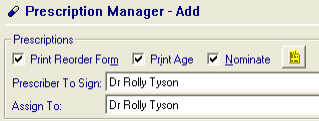Issuing Prescriptions - Overview for Administrative Staff
The steps below provide an overview for administrative staff for issuing and allocating electronic prescriptions. See "Prescription Manager and EPS" for more detailed information on Prescription Manager.
- From Consultation Manager, select the patient.
- Select the Therapy tab and add or issue the acute/repeat therapy as usual.
- Press F9 to display PrescriptionManager. Check the details in this screen. You might like to change the following:

Prescriber To Sign - A single prescriber is selected during any given print or ETP operation. This prescriber is set as the author within the prescription message, and is required to re-authenticate their Smartcard passcode during the signing process.
Assign To - This denotes the intended member of staff who is next in line to process the prescriptions. This defaults to be the same as the signer, though it is possible to assign the patient’s prescriptions to another member of staff if required. The selection is stored against the prescription record and used by the bulk prescribing view to produce the list of prescriptions to process.
Prescription Notes
 - Allows you to add a note to be conveyed to the prescriber in the All Prescriptions screen. Typically, this holds details of a requested change to the prescribed items. This also uses the existing Vision reminders system and displays alongside other reminders in the usual way.
- Allows you to add a note to be conveyed to the prescriber in the All Prescriptions screen. Typically, this holds details of a requested change to the prescribed items. This also uses the existing Vision reminders system and displays alongside other reminders in the usual way.
- It is advised that you also check the type of prescription that has been generated:
 Electronic signed electronic message. The message is the legal entity.
Electronic signed electronic message. The message is the legal entity. Electronic +Token - For if the patient requires a paper copy of the electronic prescription. The message is the legal entity.
Electronic +Token - For if the patient requires a paper copy of the electronic prescription. The message is the legal entity.- Dual - a single ETP message and dual signed script/token. Paper is the legal entity.
 Paper (signed script only, eg FP10) - this is the only icon you can see if ETP is not enabled. Paper is the legal entity.
Paper (signed script only, eg FP10) - this is the only icon you can see if ETP is not enabled. Paper is the legal entity.
- Select Finalise
 .
. - The electronic prescriptions are sent to the prescriber for signing. These are found in Consultation Manager - All Prescriptions – Authorised, or All Prescriptions - Review Required, if a note has been added or an item was on its last issue.